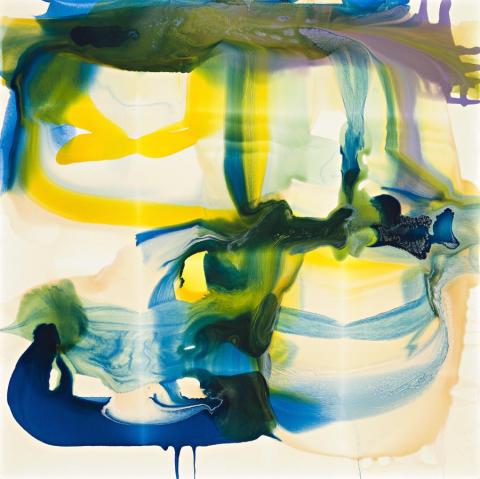THE CRITIC LOVED AND PRAISED HIS WORK. HE PRAISED AND LOVED THE CRITIC. IT WAS INDEED HIS TIME AND HIS BEST WORK, HIS LIPS NEVER PASSED A LIE, BUT MUCH MORE., 2006
DALE FRANK
varnish on canvas
200.0 x 200.0 cm
Roslyn Oxley9 Gallery, Sydney
Private collection, Sydney
Dale Frank, Roslyn Oxley9 Gallery, Sydney, 2 – 27 May 2006, cat. 22 (label attached verso)
In 1975 at just 16 years of age, Dale Frank was awarded the Red Cross Art Prize by John Olsen. Within a decade, Frank had achieved international success, exhibiting widely in commercial as well as public galleries. His works were selected for display in 1983 Perspecta at the Art Gallery of New South Wales with the following year consolidating his career through inclusion in Australian Art - An American Perspective at the Guggenheim Museum in New York and Aperto '84 at the Venice Biennale.
In the ensuing decades, Frank has continued to produce works of startling vitality. Colours slide and creep across the canvas, trapped beneath a veneer of oily varnish. At times vertiginous, the painterly plane appears to tilt before the viewer, causing the colour to pool before slipping off the edges. As noted in the Art Gallery of New South Wales Contemporary Collection publication, 'The titles of Frank's paintings are often long, and at times poetic or ironic, implying content yet eschewing interpretation while embodying his idea of the painting as a living entity, constantly changing and transgressing its form and meaning.'1
Such is the case here. What are we to make of the title of this work, inscribed on label verso in full as:
'The critic loved and praised his work. He praised and loved the critic. It was indeed his time and his best work, his lips never passed a lie, but much more.
buoyant straddle Sanchez chain kingpin Christenson cargoes conclusive steward refusal Henderson solidus gm tip intemperance aforesaid infinity lenticular.
He wanted to be the Stephan King of the Sydney artworld. Little did he know King was a done that before formula writer who had been run down twice.'
In his profile on the artist in 2008, Ashley Crawford observed that Frank's titles themselves were increasing in length, becoming something akin to short stories.2 These narratives seem both explicit yet conversely obscure, a type of automatic writing full of bombast and perversely muddled references. Perhaps only through cognitive dissonance, that peculiar human ability to hold two or more conflicting belief's as true, can we reconcile the painting itself with its ascribed title.
1. Bond, T., and Tunnicliffe, W., (eds), Contemporary, Art Gallery of New South Wales Contemporary Collection, Art Gallery of New South Wales, Sydney, 2006, p. 126
2. Crawford, A., 'Dale Frank, The Story So Far' in Art World, Issue 1, February/March 2008, p. 42
MERRYN SCHRIEVER
